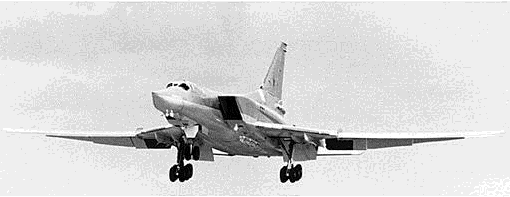Tupolev Tu-26 Backfire


This banner was supplied by SAFE Audit

Tupolev Tu-26 Backfire
Role:
Twin-engined variable geometry medium bomber and
maritime reconnaissance/attack aircraft.
DESIGN FEATURES:
Capable of performing nuclear strike, conventional
attack and anti-ship missions; low-level penetration
features ensure better survivability than for earlier
Tupolev bombers; not expected to become ALCM carriers,
although used for development launches, deployment of
RKV-500B (AS-16 'Kickback') short-range attack missiles
in Tu-22Ms has increased significantly their weapon
carrying capability. Low/mid-wing configuration;
large-span fixed centre-section and two outer steering
sleeves variable from 20 degrees to 65 degrees
sweepback; no anhedral or dihedral, but wing section so
thin that outer panels flex considerably in flight;
leading-edge fence towards tip of centre-section each
side; basically circular fuselage forward of wings,
with ogival dielectric nosecone; centre-fuselage faired
into rectangular section air intake trunks, each with
large splitter plate and assumed to embody complex
variable geometry ramps; no external area ruling of
trunks; all-swept tail surfaces, with large dorsal fin.
LANDING GEAR:
Retractable tricycle type; each mainwheel bogie
comprises three pairs of wheels in tandem, with two
forward pairs farther apart than rear pairs; bogies
pivot inwards from vestigial fairing under
centre-section on each side into bottom of fuselage.
POWER PLANT:
Two unidentified turbofans, side by side in rear
fuselage, each more than 2500 kg with afterburning.
Fuel is in integral tanks in wing central section and
steering sleeves and in fuselage tanks.
ACCOMMODATION:
Pilot and co-pilot side by side, under upward opening
gull-wing doors hinged on centreline; two crew members
further aft, as indicated by position of windows
between flight deck and air intakes.
AVIONICS:
Large missile targeting and navigation radar (NATO
'Down Beat') inside dielectric nosecone; radar ('Box
Tail') for tail turret, above guns. Fairing with flat
glazed front panel under front fuselage, for video
camera to provide visual assistance for weapon aiming
from high altitude. Very advanced ECM and ECCM;
infrared missile approach warning sensor above fuselage
aft of cockpit; eight chaff/flare multiple dispensers
in bottom of each engine duct between wingroot and
tailplane, another in each tailplane root fairing.
ARMAMENT:
Max offensive weapon load three Kh-22 (NATO AS-4
'Kitchen') air-to-surface missiles, one semi-recessed
under centre-fuselage, one under fixed centre-section
panel of each wing; or 24,000 kg (52,910 lb) of
conventional bombs or mines, half carried internally
and half on racks under wings and engine air intake
trunks. Internal bombs can be replaced by rotary
launcher for six Kh-15P (AS-16 'Kickback') short-range
attack missiles, with four more underwing as
alternative to Kh-22s. Normal weapon load is single
Kh-22 or 12,000 kg (26,455 lb) of bombs. Typical loads
two FAB-3000, eight FAB-1500, 42 FAB-500 or 69 FAB-250
or -100 bombs (figures indicated weight in kg), or
eight 1500 kg or 18 500 kg mines. One GSh-23
twin-barrel 23 mm gun, with barrels superimposed, in
radar directed tail mounting.
Aircraft Measures:
Length:129 ft., 11 in.
Height: 33 ft., 5{1/4} in.
Wingspan:
swept: 76 ft., 9{1/4} in.
unswept: 112 ft., 6{1/2} in
Loaded Weight: 286,600 lbs.
Aircraft Performance:
Maximum Speed: 1,265 mph
Service Ceiling: 60,000 ft.
Range: 3,400 miles
Thrust:N/A


